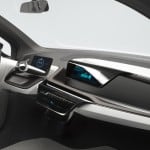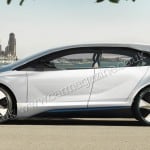The production version of BMW’s i3 electric hatchback will be ready for 2013.
The team, headed by Ulrich Kranz is already well into prototyping with both i3 and i8 undergoing early on-road trials in Miramas, BMW‘s own proving ground near Marseilles, and near the Arctic Circle. First spy shots taken of the car, show a heavily camouflaged vehicle that still fails to disguise its radical proportions, large-diameter skinny wheels and the extrovert aerodynamics
The BMW i programme has been a huge undertaking for BMW, not only because of the revolutionary engineering and design concept, but also because of the scale of the whole operation which will include the production of about 100, 000 vehicles per year.
The i3 will also be joined by the i1, i5 and i8 to round up the model range that will have a significant impact on the emerging green car market. The proposed i range features: The i3 four-door hatchback in late 2013, the i8 two-door 2+2-seater coupe in early 2014, The i5 high-roof long-wheelbase five-seater wagon/MPV hybrid potentially in 2015 and the i1 2+2-seater short-wheelbase city car potentially in 2016.
The relation between i1, i3 and i5 is said to resemble that between Polo, Golf and Golf plus/Touran.
In terms of competition, the i3 will face the even more prudent Audi A2 expected in 2014.
“Common to all BMW i vehicles are the so-called Life and Drive modules, denoting the carbon fibre body and the rolling chassis made of aluminium.” Unlike BMW’s front-engined products, i1, i3 and i5 are rear-engined which the engineers claim that the cleverly packaged battery kit dubbed energy wedge, will warrant a perfect 50:50 weight distribution. Other benefits include a low centre of gravity, the tight turning circle and a clear traction and grip advantage.
“All three rear-engined models sport a spring strut front axle and a multilink rear suspension. Supported by innovative kinematics and state-of-the-art electronics, BMW promises entertaining yet totally failsafe handling qualities.”
The i1, i3 and i5 will be available in BEV and PHEV form. The BEV relies solely on its 170bhp electric motor which propels the 1250 kilo i3 from 0-62mph in 7.9 seconds. As a range-protecting measure, the top speed is limited to about 95mph or 150kph. Sources sat that while the i1 is slightly quicker off the mark but slower overall, the i5 needs three tenths longer to get going.










